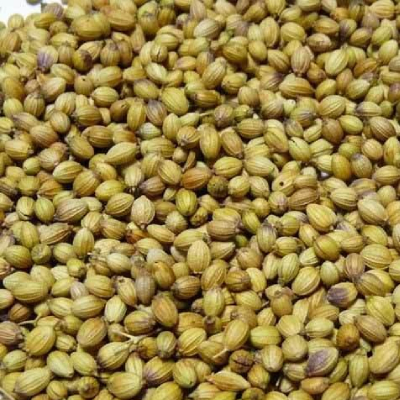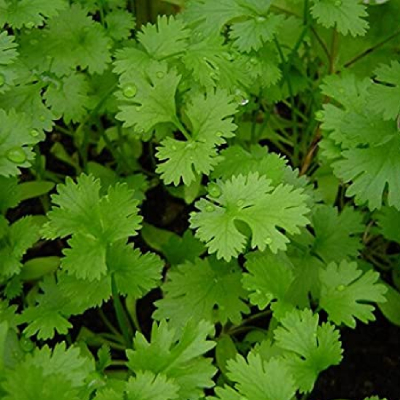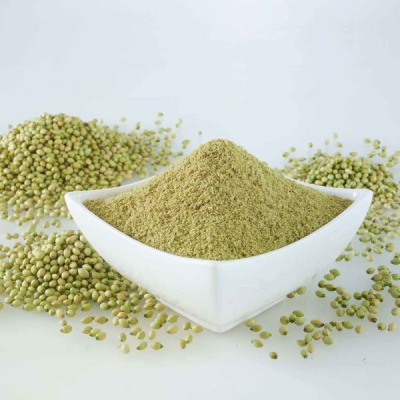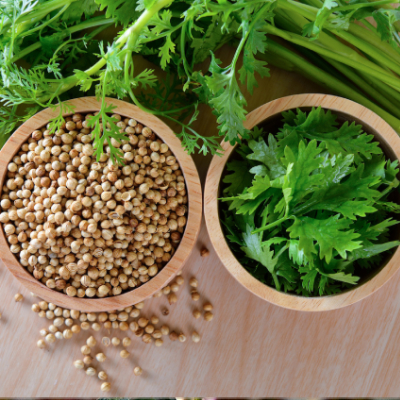CORIANDER

Coriander, also known as the Chinese Parsley, Cilantro, Dizzycorn and Japanese Parsley, is an annual herb in the family Apiaceae. It is among the the first spices used by mankind, having been known as early as 5000 BC. Its description is also mentioned in Sanskrit writings dating from about 1500 BC. Coriander is referred to in the Bible, in the books of Exodus and Numbers, where the colour of ‘manna’ is compared to it. Romans introduced it to Britain and coriander was widely used in cookery and medicine until the Renaissance, when an array of new aromatic spices replaced it. Historical findings suggest that ancient physicians like Hippocratic and Pliny were familiar to it.
In culinary context coriander refers to either the seeds of the plant (used as a spice), or to its leaves (used as a herb). Though, all parts of
coriander plant are edible, but its dried seeds and fresh leaves are widely used in cooking. Its leaves are known by the name of Cilantro in North American countries. Coriander seeds are primary ingredients of the garam masala, a blend of ground spices common in the Indian, Bangladeshi and Pakistani cuisine. The word ‘coriander’ originates from French coriandre through Latin coriandrum in turn from Greek “?????????.”
CORIANDER IN OTHER LANGUAGES
French: coriandre
German: koriander
Italian: coriandolo
Spanish: cilantro, culantro
Indian: dhanyia, dhuniah, kothimbir, kotimear, kotimli (seed)
Arabic: kizbara
Indonesian: ketumbar
Lao: phak hom pom
Tamil: kothamilee
Chinese: hsiang tsai, yen-sui, yuen sai, yuin si tsoi (leaves)
Thai: pak chee (met)
Burmese: nannambin (leaves), nannamzee (seed)
dhania patta, dhania sabz, hara dhania (leaf)
Malay: daun ketumba(r) (leaves), ketumba(r) (seed)
Sinhalese: kottamalli (seed), kottamalli kolle (leaves)

Coriander Seeds

They are spherical in shape with a slightly pointed and flattened ends. Coriander Seeds are generally 3 – 5 mm (1/8” – 3/16”) in length and the colour, when dried, is usually brown, but may be green or off white. These tan-colored, ribbed and lightweight fruits have a distinctive fragrance and orange or lemon like flavor, due to the presence of the terpenes linalool and pinene. They are usually dried but can be eaten green.
They are widely used as spices in preparing pork, curries, Middle Eastern dishes, vegetables, stewed fruit, chutney, pickles, cakes, biscuits, lentils, etc. For obtaining superlative flavour, whole coriander seeds should be used within six months, or stored for no more than a year in an air tight container, away from sunlight and heat.
INGREDIENTS
CORIANDER FRUIT OR SEED CONTAINS ABOUT 1 PER CENT OF VOLATILE OIL, WHICH IS THE ACTIVE INGREDIENT. OTHER INGREDIENTS INCLUDE:
Moisture:6.3 %
Protein:1.3 %
Volatile oil:0.3 %
Non-volatile ether extract: 22 %
Total ether extract (fat):19.6 %
Crude fiber:31.5 %
Carbohydrates:24.0 %
Total ash:5.3 %
Calcium: 0.08 %
Phosphorus: 0.44 %
Sodium:0.02 %
Potassium: 1.2 %
Vitamin B1: 0.26 mg/100
Vitamin B2: 0.23 mg/100g
Niacin:3.2 mg/100g
Vitamin C (ascorbic acid): 12.0 mg/100g
Vitamin A: 175 i.u./100g.

CORIANDER LEAVES
Coriander is one of a few plants that can be termed as a herb or a spice- the seeds being used as spices and leaves are widely used as herbs. This is the most widely used plant in both forms. Interestingly, fruits and leaves posses totally different flavour, and can therefore not substitute each other, but complement each other very well in various dishes.
The leaves are are always bought fresh as dried coriander looses its fragrance. The base leaves are broad, similar to Italian parsley, and are reputed for the better flavour. Coriander is a herb that most people either love or hate. Some people like its refreshing and lemony-ginger aroma, while other finds it soapy and irritating.
Its flavour is strong, yet delicate and complex, with notes of lemon and ginger. Coriander leaves are widely used in making chutneys, pastes and raitas when combined with other herbs and spices such as green chillies and mint.
composition
CORIANDER FRESH LEAVES HAVE FOLLOWING COMPOSITION:
Moisture:87.9 %
Protein:3.3 %
Carbohydrates:6.5 %
Total ash:1.7 %
Calcium:0.14 %
Phosphorus:0.06 %
Iron:0.01 %
Vitamin B2: 60 mg/100g
Niacin:0.8 mg/100 g
Vitamin C (ascorbic acid): 135 mg/100 g
Vitamin A:10,460 I.U./100 g.
CORIANDER POWDER
Coriander is widely used as a powdered form in almost every Indian cuisine. It is obtained from the Coriander seed of the coriander plant. The powder is prepared by selecting the high quality of matured sundried coriander of fine quality. This assures fresh taste and aroma to any dish to which these are added.
CORIANDER ESSENTIAL OIL
Coriander oil is extracted from Coriandrum sativum of the Umbelliferae (Apiaceae) family and is also known as coriander seed and Chinese parsley.
For centuries it has been widely used in aromatherapy to treat mental fatigue. The therapeutic properties of coriander oil are analgesic, aphrodisiac, antispasmodic, carminative, depurative, deodorant, digestive, carminative, fungicidal, lipolytic, stimulant and stomachic.

